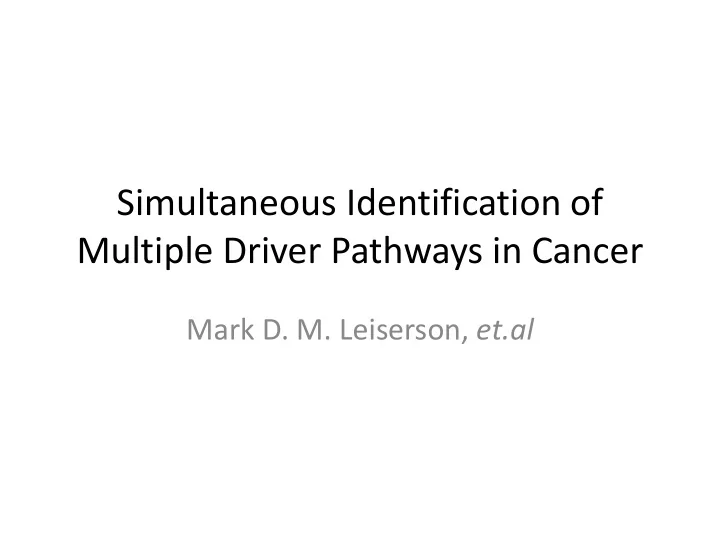

Simultaneous Identification of Multiple Driver Pathways in Cancer Mark D. M. Leiserson, et.al
Goal • To distinguish the functional driver mutations responsible for cancer development from the random passenger mutations that have no consequences for cancer.
Multi-Dendrix • Dendrix – De novo Driver Exclusivity • Important Assumption: 1) High Coverage- most patients have at least one mutation in the set, i.e, set of potential mutated genes of a particular pathway 2) High Exclusivity- nearly all patients have no more than one mutation in the set
Justification by the author From Vandin, et al, 2012
Dendrix - Method From Vandin, et al, 2012
Dendrix Method Maximum Coverage Exclusive Submatrix Problem : Given an m*n mutation matrix A and an integer k>0, find a mutually exclusive m*k submatrix of M of k columns (genes) of A with the largest number of nonzero rows (patients). Coverage Overlap Denote the set of patients in which g is mutated Denote the set of patients in which at least one of the genes in M is mutated Weight From Vandin, et al, 2012
Dendrix Method Maximum Weight Submatrix Problem : Given an m * n mutation matrix A and an integer k >0, find the m * k column submatrix M of A that maximizes W (M). Problem Computationally Difficult to Solve Size k = 6 of 20,000 genes 10^ 23 subsets Solution A greedy Algorithm for independent genes Markov Chain Monte Carlo (MCMC) From Vandin, et al, 2012
Limitation of Dendrix • Mutations in different pathways may not be mutually exclusive. • Mutations in different pathways may exhibit significant patterns of co-occurrence across patients. • Solution -> Multi-Dendrix Algorithm
Multi-Dendrix Algorithm • 1) Find sets of genes with high coverage as an integer linear program (ILP) • 2) Generalize the ILP to simultaneously find multiple driver pathways • 3) Additional Analysis: Subtype-specific mutations, stability measures, permutation test, compute enrichment states
The Multi-Dendrix Pipeline
Multi-Dendrix Method - the same as the first step of Dendrix Maximum Coverage Exclusive Submatrix Problem : Given an m*n mutation matrix A and an integer k>0, find a mutually exclusive m*k submatrix of M of k columns (genes) of A with the largest number of nonzero rows (patients). Coverage Overlap Denote the set of patients in which g is mutated Denote the set of patients in which at least one of the genes in M is mutated Weight
ILP- Integer Linear Programming • Mathematical optimization or feasibility program where variables are restricted to be integers From Wikipedia
ILP for the Maximum Weight Submatrix Problem Mutation matrix: For each gene j, a gene set M is determined by For each patient I, the coverage is determined b y
Denote the set of patients in which g is mutated Denote the set of patients in which at least one of the genes in M is mutated
Multiple Maximum Weight Submatrices Problem Multiple Maximum Weight Submatrices Problem : Given an m*n mutation matrix A and an integer t>0, find a collection M = { M1, M2, …., Mt} of m*k column submatrices that maximizes
Multi-Dendrix Results on the GBM Dataset
Multi-Dendrix Results on the BRCA Dataset
• Thank you for your attention!
Recommend
More recommend